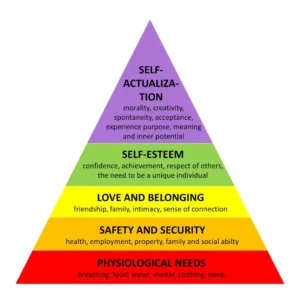
Getting people into a home is only part of solving the housing crisis. Keeping people in their homes allows them to lead happier lives and reduces long-term costs to society. There are evidence-based housing stability strategies that, when used well, can prevent other negative outcomes of lost or interrupted housing, such as harms to physical and mental health, education, family unity and stability, and dis-continuity of
benefits tied to an address.
Continued evaluation of these strategies enables policymakers to hone and maintain the effectiveness of these programs.
This policy brief summarizes research evidence of key factors to help keep people—in various stages of life— in their homes, and provides examples of related evidence-based programs.
What prompts housing instability?
- Physiological needs such as breathing, food, water, sleep are among the most basic needs a person has, and enable higher level needs to be realized and fulfilled—ultimately leading to a happier and healthier life. Housing is essential to these physiological needs.
- Risk factors such as job instability, physical and mental health challenges, and family care needs and family instability, can threaten a person’s ability to stay housed.

Policy Options: Evidence-Based “Keys” to Stability
Risk factors for housing instability look different for different people and in different communities in regions across Colorado. Research consistently shows that there are four primary ways to mitigate risks and keep people in their homes
1. Decrease the financial burden of housing
- Reduce the amount that a household spends on their home through, for example, housing vouchers and rental assistance.
- Example: One successful voucher program, HOPWA, established nearly 30 years ago, provides improved housing opportunities for people with HIV/AIDS. The most recent data suggest that 96% of recipients achieve housing stability—not to mention improved health outcomes.
- Example: Likewise, rental assistance and mortgage assistance offered to veterans is successful in reducing the financial burdens of housing.
2. Address causes of potential disruptions
- Untreated health conditions and/or unsafe conditions at home disrupt housing stability.
- Assisting individuals with substance use disorder (SUD) improves safety and stability for everyone who lives in the home.
- Example: Colorado’s Revised statute 27-80-125 already does this; it provides vouchers and case management for people with SUD who are in or seeking treatment. Case management services help individuals get to their appointments, stay on medication, and work on SSI/disability so that people can stay housed.
3. Support the livability and safety of homes
- Making physical space livable and safe is particularly important for the aging population, those with different physical or mental abilities, and/or those who have experienced homelessness.
- Example: The CAPABLE intervention, which has been tested in Colorado, provides in-home sessions with occupational therapy and nursing services, as well as basic home repairs to make sure that their homes are a safe place where household members can function and thrive.
4. Limit displacement from housing
- Instability begets instability in the same way that stability begets further stability.
- Eviction moratoriums and protections for renters support an individual’s ability to stay housed, as well as their health and employment. Because of these relationships, it is cost effective, in both the short- and long-term, to not evict people.
Leveraging these evidence-based keys in policymaking can help Colorado better achieve housing stability and address the housing crisis
Key Information
Seminar Website
Family Impact Seminars
More Seminars
Family Impact Seminars
Publication DateApril 17, 2025
Topic Area(s)Social Services
Resource TypeWritten Briefs
Share This Page
Getting people into a home is only part of solving the housing crisis. Keeping people in their homes allows them to lead happier lives and reduces long-term costs to society. There are evidence-based housing stability strategies that, when used well, can prevent other negative outcomes of lost or interrupted housing, such as harms to physical and mental health, education, family unity and stability, and dis-continuity of
benefits tied to an address.
Continued evaluation of these strategies enables policymakers to hone and maintain the effectiveness of these programs.
This policy brief summarizes research evidence of key factors to help keep people—in various stages of life— in their homes, and provides examples of related evidence-based programs.
What prompts housing instability?
- Physiological needs such as breathing, food, water, sleep are among the most basic needs a person has, and enable higher level needs to be realized and fulfilled—ultimately leading to a happier and healthier life. Housing is essential to these physiological needs.
- Risk factors such as job instability, physical and mental health challenges, and family care needs and family instability, can threaten a person’s ability to stay housed.

Policy Options: Evidence-Based “Keys” to Stability
Risk factors for housing instability look different for different people and in different communities in regions across Colorado. Research consistently shows that there are four primary ways to mitigate risks and keep people in their homes
1. Decrease the financial burden of housing
- Reduce the amount that a household spends on their home through, for example, housing vouchers and rental assistance.
- Example: One successful voucher program, HOPWA, established nearly 30 years ago, provides improved housing opportunities for people with HIV/AIDS. The most recent data suggest that 96% of recipients achieve housing stability—not to mention improved health outcomes.
- Example: Likewise, rental assistance and mortgage assistance offered to veterans is successful in reducing the financial burdens of housing.
2. Address causes of potential disruptions
- Untreated health conditions and/or unsafe conditions at home disrupt housing stability.
- Assisting individuals with substance use disorder (SUD) improves safety and stability for everyone who lives in the home.
- Example: Colorado’s Revised statute 27-80-125 already does this; it provides vouchers and case management for people with SUD who are in or seeking treatment. Case management services help individuals get to their appointments, stay on medication, and work on SSI/disability so that people can stay housed.
3. Support the livability and safety of homes
- Making physical space livable and safe is particularly important for the aging population, those with different physical or mental abilities, and/or those who have experienced homelessness.
- Example: The CAPABLE intervention, which has been tested in Colorado, provides in-home sessions with occupational therapy and nursing services, as well as basic home repairs to make sure that their homes are a safe place where household members can function and thrive.
4. Limit displacement from housing
- Instability begets instability in the same way that stability begets further stability.
- Eviction moratoriums and protections for renters support an individual’s ability to stay housed, as well as their health and employment. Because of these relationships, it is cost effective, in both the short- and long-term, to not evict people.
Leveraging these evidence-based keys in policymaking can help Colorado better achieve housing stability and address the housing crisis

Key Information
Seminar Website
Family Impact Seminars
More Seminars
Family Impact Seminars
Publication DateApril 17, 2025
Resource TypeWritten Briefs
Share This Page
LET’S STAY IN TOUCH
Join the Evidence-to-Impact Mailing List
Keep up to date with the latest resources, events, and news from the EIC.



